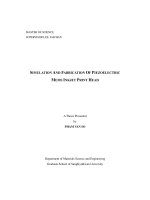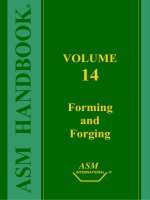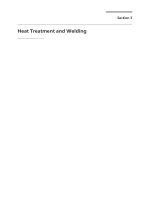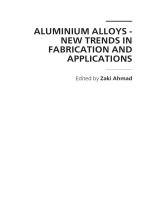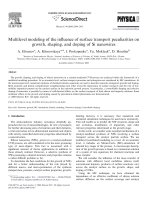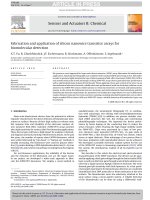Undertake fabrication, forming, bending and shaping
Bạn đang xem bản rút gọn của tài liệu. Xem và tải ngay bản đầy đủ của tài liệu tại đây (4.98 MB, 73 trang )
5.10A
Undertake Fabrication,
Forming, Bending and
Shaping
5.10A Undertake Fabrication, Forming, Bending and Shaping
In the fabrication industry the manufacture of and item
involves one or more of the following: Welding
Cutting
Forming
Usually several of these processes are combined to
manufacture an item.
Machinery used in forming is varied as with the other
processes, it can be by any of the following equipment: Pressing Equipment
Heating Equipment
Rolling Equipment
Bending Equipment
Forming can be done in the hot (plastic) or the cold state.
5.10A Undertake Fabrication, Forming, Bending and Shaping
Forging
Iron & steel can be easily shaped when heated.
This increases their plasticity and workability.
Material is hammered whilst heated red.
Today hot forging uses roughly the same process
with upper & lower dies and power presses
producing the product.
Process is used for:
Automotive products
Connecting Rods
Crankshafts
Socket Wrenches
Suspension Springs
5.10A Undertake Fabrication, Forming, Bending and Shaping
Contra Heating
Contra Heating
is the technique of concentrating heat on a small area of a metals surface
due to the surrounding metal being cooler the expansion is restricted
hence the metal distorts as it cools (contacts)
USED For:-
cambering rolled sections
flame straightening
Methods Flame Straightening
removes a curve, bow made during manufacture
contra heating is used to straighten these projects
Cambering
is the process of deliberately bending a section during manufacturing (curve).
this allows a section to straighten under loads in service
5.10A Undertake Fabrication, Forming, Bending and Shaping
Chambering
Methods of Chambering depend on the section
The size of structural section
Amount of chamber required
Equipment available in the workshop
Capacity of the equipment
The most common methods of chambering
Fabricated Chambered Beam
Heat and shrinkage
Beam press (Discussed later)
Section Rolls
5.10A Undertake Fabrication, Forming, Bending and Shaping
Folding Machines
These folding machines are used for both bending and folding
depending on how they are adjusted.
There are many different types of machines, they are: Bench folder
Pan Brake (box)
Cornice folder
Angle bender
Bar Bender
‘H’ frame press
Gap head press
Column Press
Press Brake
5.10A Undertake Fabrication, Forming, Bending and Shaping
Folding Machines
Bench folder
The bench folder is designed to
bend sheet metal to form edges
and prepare the metal for a wire
edge.
Seams can also be formed .
Single and double hem.
The width of the folded edge is
determined by the setting of a
depth gauge adjustment.
5.10A Undertake Fabrication, Forming, Bending and Shaping
Folding Machines
Pan brake or box folder
The pan brake is used to form boxes and trays.
Top blade has splits in it or is made up of a
series of small adjustable blades.
These blades can be removed or adjusted to
allow the sides of boxes or trays to be bent.
For production work the use of a back gauge is
preferable.
A new adaptation of this type of folder is the
magnetic folder.
It is lighter in construction and can be used to
form practically any shape required.
Operator can make their own dies by cutting
any ferrous material to suit any situation.
5.10A Undertake Fabrication, Forming, Bending and Shaping
Folding Machines
Cornice Folder
Machine bending is faster and more accurate than hand bending by
hammers.
Used for making bends in thin gauged plates up to 3mm.
Machine made of a heavy cast section to with-stand bending stresses.
The top blade is usually one piece therefore boxes and pans cannot be
bent.
The bar or bottom blade can be either 6mm
or 12mm in width.
!2mm preferred for general fabrication.
6mm is necessary for making narrower
or reverse bends.
5.10A Undertake Fabrication, Forming, Bending and Shaping
Folding Machines
Angle bender
The angle bender is portable and can be fastened to a workbench by bolts
or clamps.
It has a simular action to a brake press.
A vertical up & down motion of the blade.
It uses knife blades and vee blocks to form the required shape.
The machine is used for sheet metal to bend
angles up to 90o.
The length of the bend is restricted by
the size of the machine.
The angle bender picture, incorporates a set
of rolls and guillotine blade in the one
machine.
5.10A Undertake Fabrication, Forming, Bending and Shaping
Folding Machines
Bar bender
This machine is used to bend flat and round
bars by hand.
The machine has a fixed position clamping
head and an adjustable moving head.
The sharpness of the bend is determined by
the adjustment of the movable head.
Bends of 90o can be performed with this
machine.
The shape or configuration of the bend is
determined by the size of the machine and
the clamping head width.
5.10A Undertake Fabrication, Forming, Bending and Shaping
Folding Machines
‘H’ Frame press
The ‘H’ frame press may be hand, eclectically or hydraulically
operated.
Has an adjustable bottom bed.
Pin secure the bed in place and must be removed before
adjustment.
Breaking of wire controls can occur.
Replacement is required before any pressing occurs.
Used for
Presetting light plates for rolling.
Dishing of cylinder ends.
Breaking of fillets welds for weld procedures and
testing.
Straightening of small jobs.
Cutting keyways.
Removing bearings and bushes from shafts.
5.10A Undertake Fabrication, Forming, Bending and Shaping
Folding Machines
Gap Head Press (‘C’ frame)
This press is capable of a variety of forming depending on
the shape of the dies.
The accuracy of the machine depends on the user’s skill.
Used for
Correcting distortion.
Straightening.
Dished ends (hot or cold).
Pre-setting heavy plates for rolling.
Forming heavy plates.
Punching or piecing.
5.10A Undertake Fabrication, Forming, Bending and Shaping
Folding Machines
Column Presses
100 tonne to 1000 tonne capacities.
Single, double and triple action designs.
Use mainly in the car industry.
Used for
Pressing heavy sections.
Straightening.
Dished ends.
Progressive flanging.
Folding.
Square and radii bends.
Piercing.
These machines do not normally have adjustable
strokes.
5.10A Undertake Fabrication, Forming, Bending and Shaping
Folding Machines
Brake Press
These presses have an adjustable blade.
Blade depth can be varied throughout pressing.
Can be CNC controlled.
Wide variety of dies are available.
Used with air bend or bottoming dies.
Useful for repetitive work.
Used for
Angle bends
Radii & presetting ends of cones and
cylinders before rolling.
Long bends
Flanging
Box making
Corrugations
Channel forming
Flattening
Repetition pressing
5.10A Undertake Fabrication, Forming, Bending and Shaping
Folding Machines
Safety
Check that all dies are correctly fitted & secure.
Check that the work area around the machine is clear and clean.
Check the capacity of the machine.
Check the die opening is correct.
Check that all safety devices are working properly.
Keep your hands clear of dies.
Keep your body away from moving material during forming.
One person only should be responsible for using the machine.
No skylarking.
Be careful when lifting dies or material.
5.10A Undertake Fabrication, Forming, Bending and Shaping
Folding Machines
Dies
The types of die blocks used to form bends are: Vee blocks
Dies
They are selected according to: Thickness of plate
Minium bend radius
Standard dies available include: Knife and vee
Acute angle knife and vee
Special purpose blocks and dies
depending on the shape (form) of the bent
article.
Dies and blocks can be manufacture to suit most if not all needs
required, frequency of use & costing is the limiting factor
5.10A Undertake Fabrication, Forming, Bending and Shaping
Folding Machines
Die openings
The recommended die ratio is 8 x material thickness.
If the die ratio is less than 8, the force required to bend the
material will be increased.
The danger with this is the material may fracture along
the bend line.
Larger ratio’s may mean, more material is drawn into the
die.
The danger here is a bulge may occur on the outside of
the bend radius.
8 x Material
Thickness
5.10A Undertake Fabrication, Forming, Bending and Shaping
Folding Machines
Bending
The bending of metals in a brake press can be done either by
air bending or bottoming.
Bottoming
When using the bottoming method the material is force to the
contour of the bottom die.
This process requires greater force.
Press sizes and capacities are increased.
Dies required accuracy when setting up. setup
Common in the car industries for pressing panels.
Air bending
With air bending the material is not forced completely into the
bottom of the die.
A air space remains between the underside of the
material and the bottom of the vee die.
4 to 6 times less force is required for air bending.
Angles slightly greater than 90o can be pressed.
5.10A Undertake Fabrication, Forming, Bending and Shaping
Folding Machines
Spring Back
Spring back occurs when a plate is pressed, this is due to
the air gap between the bottom die and the material being
pressed.
When the top die retracts the plate springs back due to
the elasticity of the material.
Spring back needs to be allowed for when using Air
Bending dies.
The amount of spring back varies depending on the: The ratio of bend radius to sheet thickness.
Angle of the bend.
Method of bending
Vee bending or wiping.
The amount of compression in the bend zone.
Tool wear.
Power input variations.
Spring back can be controlled by over-bending or by
restriking the bend area with more pressure.
5.10A Undertake Fabrication, Forming, Bending and Shaping
Folding Machines
Flexible Dies
These types of dies are made of a elastomer type material.
They are used in a normal 50mm Vee block opening.
The flexible die deforms under load, matching the shape of
the male die.
Advantages
Extremely accurate without additional tooling costs.
No tooling makes on the outside surface.
Damage sections can be replaced by cutting the
damaged area out and replacing it.
Can be used to form short flanges which normal Vee
block opening cannot accommodate.
Disadvantages
Flexible dies are more expensive.
Larger capacity machines are require.
In practice it is the same as for bottoming pressing.
5.10A Undertake Fabrication, Forming, Bending and Shaping
Folding Machines
Pressing chart
Most presses these days come with a
pressing chart it shows the following
information: Plate thicknesses
Vee block openings “V”
Bend radius “R”
Minimum edge plate allowance “B”
These are all equated to the maximum
tonnage per metre of material: Those in black are the preferred
material thickness for the Vee block
opening.
The charts are also used to determine the
mean bend allowance for the Vee block
used @ radius “R”.
5.10A Undertake Fabrication, Forming, Bending and Shaping
Folding Machines
Bend Calculations
When bending operations are required the general rule is to use the inside
dimensions of a job.
How ever it is strongly recommended to make a test press with
predetermined measurements.
Checks of these measurements are made after bending to see if any
material is taken up in the bent material.
If there is a difference in measurements an allowance for a bend radius is
required.
The radius of the bend can be checked using radius gauges.
Where a radius is found the mean dimension of the bend is used to
calculate this allowance.
Mean is = inside radius + ½ the material thickness.
The formula for working out the allowance is:-
MD x π x Bend Angle
3600
5.10A Undertake Fabrication, Forming, Bending and Shaping
Folding Machines
CHECKING the PRESSED SHAPES
To make sure work is accurate, you need to check during and after pressing.
Check both ends of the blade for alignment to be parallel.
Check along the length of press to avoid bowing.
If bowing occurs over press and dress after.
The following methods can be used to check pressing:
INTERNAL TEMPLATES
EXTERNAL TEMPLATES
CHECKING over LAYOUT
5.10A Undertake Fabrication, Forming, Bending and Shaping
Folding Machines
A gain of 10 mm in
both dimensions
50
10
10
75
10
75
